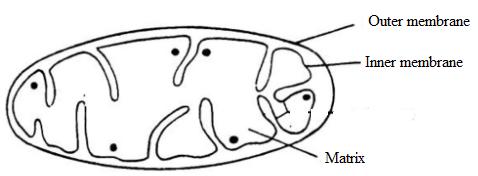
Concept explainers
Interpretation:
The main features of mitochondrion and place where the production of energy takes place in the mitochondrion are to be determined.
Concept introduction:
The term cytoplasm refers to the thick solution which fills each cell present in living organisms and is enclosed by a cell membrane. Its composition mainly consists of water, salts and proteins. Its function is to hold the internal components present in a cell in their respective places and to save them from any kind of damage.
Answer to Problem 23.17P
Mitochondrion refers to a small organelle that is placed in the cytoplasm of the cell. It consists of an outer membrane and inner membranes with a number of folds. The production of the energy occurs in the matrix present in the mitochondrion.
Explanation of Solution
Mitochondrion refers to a small organelle that is placed in the cytoplasm of the cell. It consists of an outer membrane and inner membranes with a number of folds. The area between these two membranes is called the intermembrane space and this area is further surrounded by an inner membrane of the mitochondrion called the matrix.
The production of the energy occurs in the matrix present in the mitochondrion. It is also to be noted that the number of mitochondria in a given cell differs from cell to cell as this number depends upon the energy needs of the cell. The skeleton diagram of the mitochondrion is as shown below:

The mitochondrion is present in the cytoplasm of the cell. The production of the energy occurs in the matrix present in the mitochondrion.
Want to see more full solutions like this?
Chapter 23 Solutions
EBK GENERAL, ORGANIC, & BIOLOGICAL CHEM
- drawing, no aiarrow_forwarddrawing, no aiarrow_forwardDraw the major organic product when each of the bellow reagents is added to 3,3-dimethylbutere. ✓ 3rd attempt Part 1 (0.3 point) H.C CH CH + 1. BHG THF 210 NaOH NJ 10000 Part 2 (0.3 point) HC- CH HC 2741 OH a Search 1. He|DA HO 2. NIBH さ 士 Ju See Periodic Table See Hint j = uz C H F F boxarrow_forward
- Indicate the product formed in each reaction. If the product exhibits tautomerism, draw the tautomeric structure. a) о + CH3-NH-NH2 CO2C2H5 b) + CoH5-NH-NH2 OC2H5arrow_forwardIndicate the formula of the compound, that is the result of the N- alquilación (nucleofílic substitution), in which an additional lateral chain was formed (NH-CH2-COOMe). F3C. CF3 NH NH2 Br о OMe K2CO3, DABCO, DMFarrow_forwardSynthesis of 1-metilbenzotriazole from 1,2-diaminobenceno.arrow_forward
 General, Organic, and Biological ChemistryChemistryISBN:9781285853918Author:H. Stephen StokerPublisher:Cengage Learning
General, Organic, and Biological ChemistryChemistryISBN:9781285853918Author:H. Stephen StokerPublisher:Cengage Learning Organic And Biological ChemistryChemistryISBN:9781305081079Author:STOKER, H. Stephen (howard Stephen)Publisher:Cengage Learning,
Organic And Biological ChemistryChemistryISBN:9781305081079Author:STOKER, H. Stephen (howard Stephen)Publisher:Cengage Learning, Chemistry for Today: General, Organic, and Bioche...ChemistryISBN:9781305960060Author:Spencer L. Seager, Michael R. Slabaugh, Maren S. HansenPublisher:Cengage Learning
Chemistry for Today: General, Organic, and Bioche...ChemistryISBN:9781305960060Author:Spencer L. Seager, Michael R. Slabaugh, Maren S. HansenPublisher:Cengage Learning Introduction to General, Organic and BiochemistryChemistryISBN:9781285869759Author:Frederick A. Bettelheim, William H. Brown, Mary K. Campbell, Shawn O. Farrell, Omar TorresPublisher:Cengage LearningChemistry: Matter and ChangeChemistryISBN:9780078746376Author:Dinah Zike, Laurel Dingrando, Nicholas Hainen, Cheryl WistromPublisher:Glencoe/McGraw-Hill School Pub Co
Introduction to General, Organic and BiochemistryChemistryISBN:9781285869759Author:Frederick A. Bettelheim, William H. Brown, Mary K. Campbell, Shawn O. Farrell, Omar TorresPublisher:Cengage LearningChemistry: Matter and ChangeChemistryISBN:9780078746376Author:Dinah Zike, Laurel Dingrando, Nicholas Hainen, Cheryl WistromPublisher:Glencoe/McGraw-Hill School Pub Co





